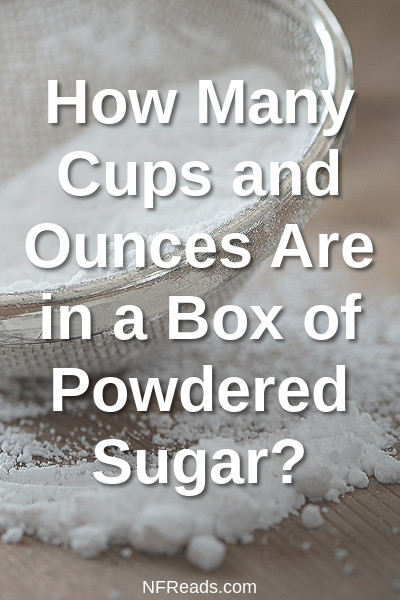How Many Cups In 1 Box Of Confectioners Sugar

By the NFReads.com editorial team
Powdered or confectioner's sugar is often sold in 1 or 2 pound numberless or boxes (=xvi or 32 oz), but most recipes typically utilise smaller amounts in varying units of measurement. Beneath is a table to catechumen between ounces, cups and pounds, but read on for some caveats on why information technology isn't 100% precise.
| Initial amount: | 1 ounce | 1 cup | 1 pound | 2 pounds |
| ..is this many ounces | one | four.673 | 16 | 32 |
| ..is this many cups | 0.214 | 1 | 3.424 | 6.847 |
| ..is this many pounds | 1/16 | 0.292 | 1 | ii |
According to the Food and Agriculture Organization of the United Nations' International Network of Nutrient Data Systems Density Database Version 2.0 (a mouthful, simply at least you know you lot tin can trust information technology), powdered sugar has a bulk density of 0.56 grams (this was reportedly truncated to two decimal places) per milliliter at a temperature of 4 degrees Celsius (or 39.2 degrees Fahrenheit). This was used to calculate the values in the table higher up, but two things can affect it: moisture and temperature.
Density will decrease as temperature goes up, but for applied purposes this can be ignored since it only involves changes of a fraction of a percentage – even across temperature differences of over 100 degrees. This small change becomes further irrelevant if yous mensurate using weight (ounces, grams, etc.) instead of volume (spoons, cups, etc.) since a change in density won't touch on mass.
Wet and humidity can exist a much bigger problem. When contaminated with water, yous will become less powdered sugar for the same amount of weight (which makes sense since some of the weight is at present h2o) and conversely more than for the aforementioned amount of book (this is a footling less intuitive). Why does the density increase? While dry powdered saccharide has a density of 0.56 grams per milliliter this is its "majority density" which includes the microscopic spaces of air within it (like the empty space in a jar of marbles). Water collapses this (using the marble analogy information technology would be like melting them) to bring it closer to the density of solid, crystalline sucrose of 1.59 grams per milliliter at 68 degrees Fahrenheit (source: National Institutes of Health PubChem database).
This is some other reason why sifting is necessary apart from removing clumps. So how do you lot prevent clumps from forming in the offset place? The USDA-published book Weight and Polarization Changes of Puerto Rican Raw Sugar in Storage and Shipment written by Robert Grant Martin in 1958 provides some storage advice derived from industry papers and handbooks (it looks at granular rather than powdered sugar, but the same principles apply):
- Store at beneath 75% relative humidity (moisture absorption goes from minimal below this and increases rapidly past this point) – lower is better with l% relative humidity guaranteeing zero moisture absorption
- Even in humid climates, storage in a sealed airtight place prevents any more moisture getting in
- Heat can be used to lower relative humidity as hot air can agree more h2o vapor without it condensing
How Many Cups In 1 Box Of Confectioners Sugar,
Source: https://www.nfreads.com/how-many-ounces-is-in-a-box-of-powdered-sugar/
Posted by: becerrawituare.blogspot.com


0 Response to "How Many Cups In 1 Box Of Confectioners Sugar"
Post a Comment